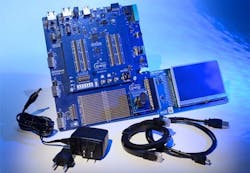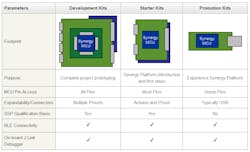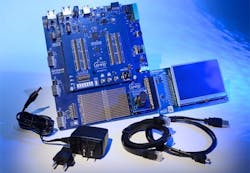Renesas’ Synergy environment encompasses a family of ARM Cortex-M microcontrollers and its supporting software and third party support. The initial announcement provided insights to the hardware and technology, but it was not until the 2015 Renesas Developer Conference that the average developer was able to get their hands on it. There is a range of platforms ranging from promotional hardware to full development kits (Fig. 1).
The Synergy family of ARM Cortex-M microcontrollers ranges from the Cortex-M0+ S1 to the Cortex-M4 S7. The chips have a robust design with advanced power management support. They also come with a range of integrated software that exceeds the typical package associated with most microcontrollers.
The environment starts with the Eclipse-based e2 Studio IDE. Express Logic’s ThreadX real-time operating system, which has been customized for the hardware as is Express Logic’s middleware that includes support such as NetX networking and the GUIX graphical interface. Support packages like the TraceX analysis tool are part of the mix as well.
Renesas provides a verified and integrated third-party selection of tools and services up through the cloud with support for environments like Zebra’s Zatar cloud service. Zatar supports the ARM mbed IoT environment. The mbed client software support is part of Renesas’ solution.
One example of the high-end development kits is the DK-S7G2 (Fig. 2). It is based on the Synergy S7 ARM Cortex-M4 microcontroller with a 240 MHz core. It has Ethernet, CAN, and USB support as well as parity on the SRAM. The chip has a true random number generator and support for 256-bit AES. On the analog side, there are 12-bit ADCs and DACs plus half a dozen high-speed comparators and an 18-channel capacitive touch unit that works with displays driven by the 2D drawing engine. On-chip memory includes 640 Kbytes of SRAM, 64 Kbytes of data flash, and 4 Mbytes of code flash.
The board exposes the processor’s interface pins and adds features like Bluetooth Low Energy (BLE) 4.0, a detachable camera interface, and 4 PMOD connectors (Fig. 3). It also augments storage with off-chip 16 Mbyte SRAM, 16 Mbyte QSPI flash, and a 2 Gbyte eMMC chip. An on-board J-Link system provides debug support. There is a detachable 4.3-in. LCD with capacitive touch support.
About the Author
William G. Wong
Senior Content Director - Electronic Design and Microwaves & RF
I am Editor of Electronic Design focusing on embedded, software, and systems. As Senior Content Director, I also manage Microwaves & RF and I work with a great team of editors to provide engineers, programmers, developers and technical managers with interesting and useful articles and videos on a regular basis. Check out our free newsletters to see the latest content.
You can send press releases for new products for possible coverage on the website. I am also interested in receiving contributed articles for publishing on our website. Use our template and send to me along with a signed release form.
Check out my blog, AltEmbedded on Electronic Design, as well as his latest articles on this site that are listed below.
You can visit my social media via these links:
- AltEmbedded on Electronic Design
- Bill Wong on Facebook
- @AltEmbedded on Twitter
- Bill Wong on LinkedIn
I earned a Bachelor of Electrical Engineering at the Georgia Institute of Technology and a Masters in Computer Science from Rutgers University. I still do a bit of programming using everything from C and C++ to Rust and Ada/SPARK. I do a bit of PHP programming for Drupal websites. I have posted a few Drupal modules.
I still get a hand on software and electronic hardware. Some of this can be found on our Kit Close-Up video series. You can also see me on many of our TechXchange Talk videos. I am interested in a range of projects from robotics to artificial intelligence.




